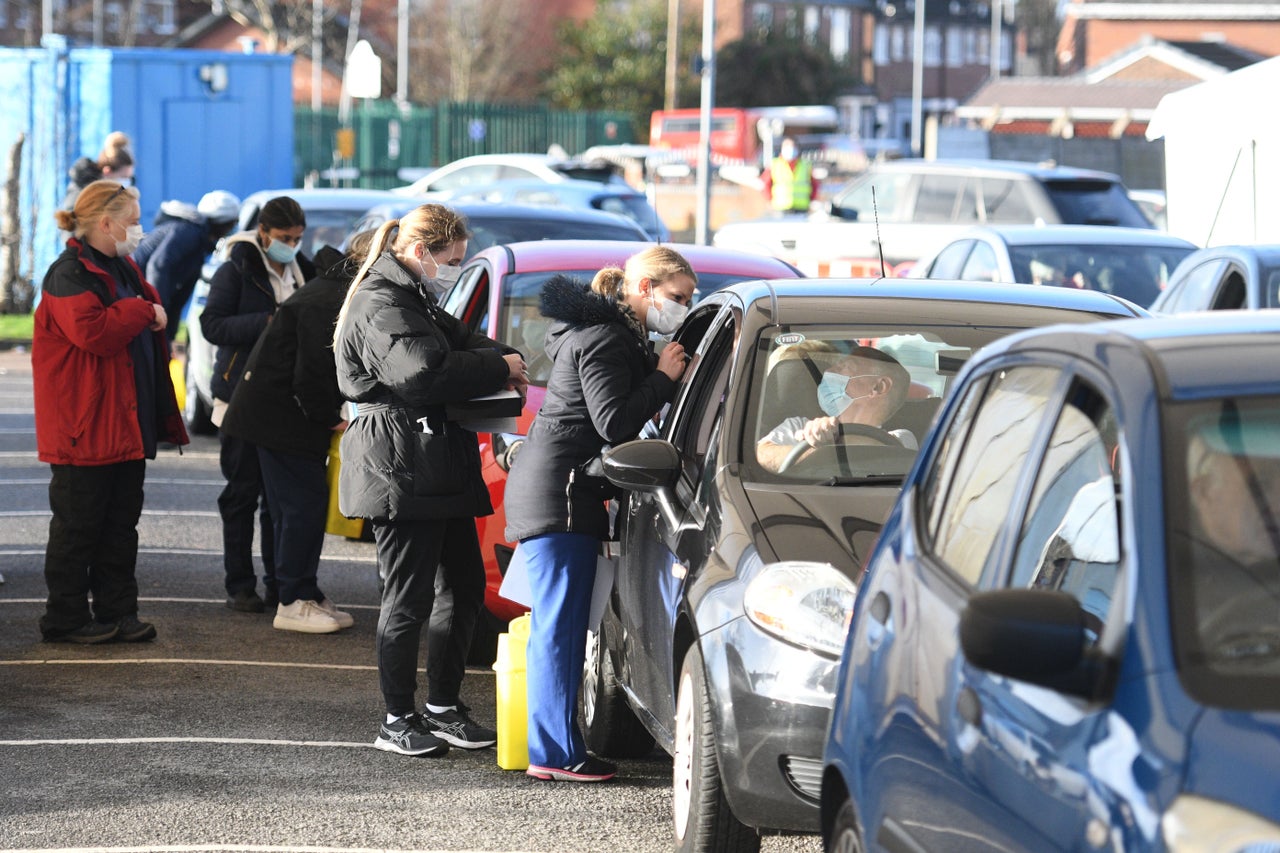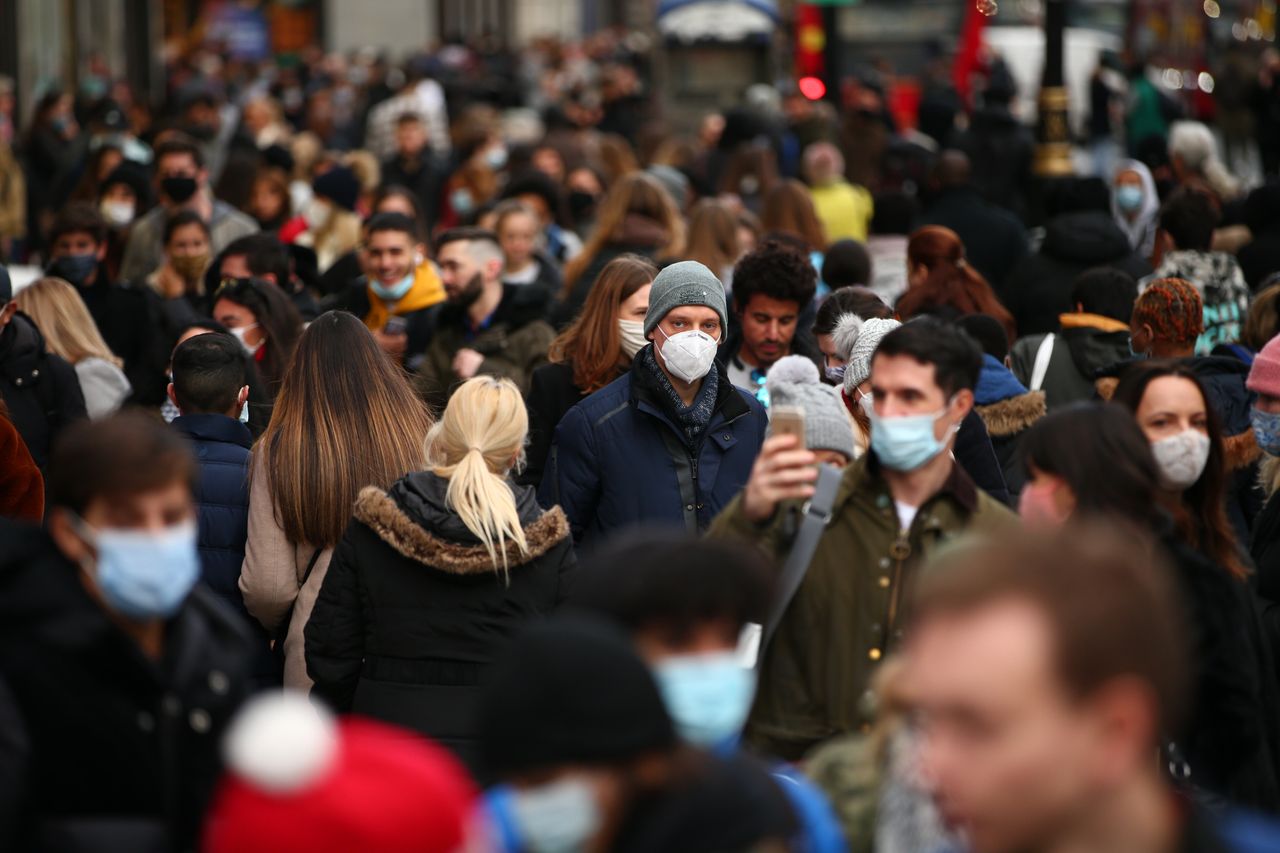The Latest
- Boris Johnson has announced Christmas relaxations will be tightened across England.
- A new tier 4 lockdown will also be introduced in London, the south-east and the east.
- We’ve explained what you can and can’t do under the new rules.
* * *
Where are we at right now?
Latest figures from the Office for National Statistics (ONS) show the proportion of people testing positive has increased sharply in London. Infection rates have also increased in eastern England, the East Midlands and south-east England.
The reproduction number, or R rate, of transmission across the UK has risen to between 1.1 and 1.2, a significant increase from last week’s estimate of between 0.9 and 1.
There are also reports of growing numbers of hospitals in England running out of beds and having to divert patients elsewhere.
So could the rise in cases and hospital admissions mean that the third wave has already started in the UK? Dr Naomi Forrester-Soto, a virologist at Keele University, doesn’t think so. “I would say what we’re seeing is the resurgence of the second wave,” she tells HuffPost UK.
“The second wave never really went away; cases never dropped down to the levels that we saw between the first and second wave.”
Professor Martin Michaelis, a molecular medical expert at the University of Kent, agrees. “The little dip in the [current] wave was just a result of the lockdown. After the first wave, it took a while until we had the second one because the first lockdown brought the numbers down quite considerably.
“We haven’t seen this happen this time.”
Is a third wave inevitable?
Experts have warned that the relaxation of the coronavirus rules over the Christmas period will lead to a rise in cases and risk overwhelming the health service at a time when it traditionally comes under the most pressure because of winter flu and other diseases. In the US and in Canada, the number of Covid cases experienced a significant surge in the period after Thanksgiving.
“I think we’ll probably see a spike in cases as a result of Christmas,” Forrester-Soto says. “It depends on how much mixing everybody does. If we can confine it to those bubbles and limit mixing to one or two other households, then that would limit the amount of transmission afterwards.
“The problem is that we’re reaching peak respiratory virus season, when we would expect to see everybody getting sick and sniffly and when flu and colds would normally take off,” she adds. “Coronavirus is no exception to that.”
“We’re not protecting lives, we’re just delaying the deaths.”
She worries the current tier restrictions just aren’t stringent enough considering the increased risk of respiratory virus infections that are associated with the winter months: “The only explanation I have for why cases are still increasing is that we’re reaching that peak respiratory infection window and the restrictions aren’t working as well as they should.”
Michaelis also believes the government’s tiered coronavirus rules aren’t doing enough to control the spread of the virus but warns against talking about the “inevitability” of a third wave. “Nothing is inevitable about this pandemic,” he says.
“We have lost almost 70,000 people but this wasn’t inevitable. There are many countries in the world such as Taiwan, Australia and Vietnam who have managed this much better, but instead what the UK is doing is these emergency lockdowns and at the same time not really suppressing the spread.
“We’re not protecting lives, we’re just delaying the deaths and distributing them over a longer period of time.”
In order to prevent a third wave, he argues the government should step up its programme of mass testing alongside mass vaccinations. “With mass testing, you can actually find the infected people and tell them to isolate themselves.”
Anyone who is exhibiting a sign of an infectious disease, regardless of whether it is one of the three main symptoms of Covid-19, should be told to self-isolate in order to limit the spread of transmission, he adds.
What impact will the vaccine have?
For now, none. “The vaccinations aren’t going to do a huge amount to prevent the rise in cases because not enough people have been vaccinated,” Forrester-Soto says.

Although it could take a long while before we see the vaccine have an impact on the number of cases, it could potentially lead to fewer hospital admissions.
“The first sign that the vaccinations are working is that hospitalisations will start going down, because the people who are most at risk of being hospitalised are the people who are going to be vaccinated first,” she continues.
“So transmissions rates could remain the same but a decline in the number of hospitalisations will indicate that we are actually protecting some of the most vulnerable people in the population.”
How would a third wave be different from the first two waves?
“The first wave of Covid-19 was felt in care homes first, whereas the second wave began among younger people, so it took longer for vulnerable people to be infected and for death levels to rise,” says Michaelis. But he’s reluctant to predict what will happen the next time.
“The big picture is that these are tiny differences. In the end, there is a level of randomness to how diseases are transmitted and which groups are affected; it’s like throwing a dice.”
Forrester-Soto agrees that the third wave will not be significantly different from the first two waves. “There’s been no real change in the way the virus interacts or causes disease,” she says.
“The only difference now is the way that we are now able to treat people and understand better how their disease progresses, so treatments are more focused and therefore have better outcomes from the very beginnings of the epidemic. But the virus itself hasn’t really changed much.”
How bad could it be?
“You just have to look across the pond to see how bad things could potentially get,” says Forrester-Soto. “In the US, their hospitals are starting to get overwhelmed; the whole country is overwhelmed. That’s pretty much where we’re headed, if we don’t all pull together and try and prevent transmission within our communities urgently.”
The timing makes the fatalities that could result from this third wave all the bleaker. “Given the hope of the vaccine and with the promise of protection just around the corner, it would be a tragedy to see those numbers rise and then with it an increase in deaths.
“There’s no reason to believe we won't be seeing tens of thousands of further deaths.”
“If everyone could just hold on and socially distance, wear masks and wash hands for the next two months, we may actually be able to make it through with fewer fatalities than we would if we saw the case numbers continue to rise.”
Michealis believes that a “reasonable” outcome based on the current trajectory of cases would 100,000 deaths in the UK by Easter. “We’re already at almost 70,000 and I don’t see why people would magically stop dying.
“Every time we relax [the rules] we see cases going up and more people dying, and so there’s no reason to believe the numbers are going to decrease any time soon. So yes, I think we’ll see tens of thousands of further deaths.”
Could there be another lockdown in the new year?
On Friday Boris Johnson refused to rule out imposing a third national lockdown on England in the new year, saying: “We’re hoping very much that we will be able to avoid anything like that. But the reality is that the rates of infection have increased very much in the last few weeks.”
Another lockdown is inevitable if things continue as they are, says Michealis. “It’s very gloomy and very dire at the moment so yes, there will be another lockdown if we keep behaving as we do at the moment. There is no other way.”
Both he and Forrester-Soto believe the next lockdown will take place sometime at the beginning of 2021. “It’s likely we’ll experience some form of lockdown in mid-January to February,” Forrester-Soto says. “With case numbers rising so dramatically something will need to be done to get them under control again.”
Michaelis argues the rules need to be as strict as those in the first national lockdown. “I think probably we have to close down everything that we do not need to survive,” he says.
That could mean even closing down schools once again. “I think we are in a very desperate situation and should probably close schools for a while. I hate to say that, but I do think it’s a prudent thing.”
Should we be still talking about ‘waves’?
According to Michaelis, the “wave” narrative that has surrounded the Covid-19 pandemic is largely because of how the Spanish Flu played out in 1918. “There were three waves, in that case, starting with a mild wave and followed by a very severe second wave, which was the biggest and worst one.
“But there’s no general concept that suggests that’s how it typically will happen. We can see now that the Spanish Flu waves were much more natural than our Covid-19 waves, so the comparison doesn’t really work.”
The danger in discussing coronavirus in terms of waves, he argues, is that we are “overcomplicating the whole pandemic”. “R values, herd immunity, thresholds and waves – these are all very academic concepts.
“In the end, it’s much easier than that. Is the disease spreading? Are the numbers going up or down? That’s it.”
Forrester-Soto says: “Waves tend to be for very seasonal viruses, where you see a wave come in the first year and then it goes away and comes back with a second wave.
“In the case of Covid-19, the virus doesn’t seem to be a very seasonal flu. We’re just seeing falls and rises in the number of cases, but the cases have never gone away.”
